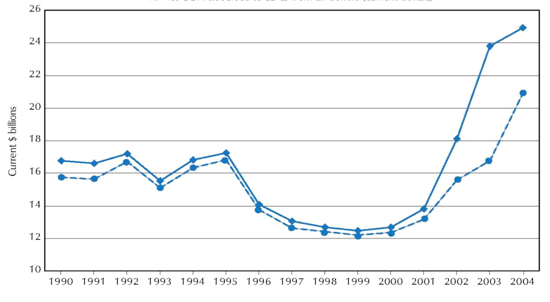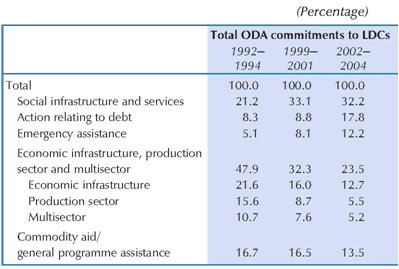More assistance should be channelled to help 50 poorest nations build productive capacities, create jobs, report recommends
| EMBARGO The contents of this press release and the related Report must not be quoted or summarized in the print, broadcast or electronic media before 20 July 2006, 17:00 GMT (1 PM New York, 19:00 Geneva) |
The economies of the world´s 50 poorest countries grew by an average of 5.9% in 2004, the highest rate in two decades, a new UNCTAD report reveals. This was associated with a doubling of aid from rich countries between 1999 and 2004, with high demand for oil and other natural resources, with record merchandise exports in 2004 of US$57.8 billion, and with a record $10.7 billion in private foreign investment.
However, The Least Developed Countries Report 2006: Developing Productive Capacities (1) warns that sustaining this progress will depend on channelling a higher proportion of aid into increased investment in productive sectors and into infrastructure improvements such as upgrading roads, ports and electricity supplies, as well as enhanced support to improve domestic financial systems, upgrade technological capabilities and support the development of local firms.
Unless more aid is channelled into building up the productive bases of LDC economies, they will remain vulnerable to sudden downturns, and substantial long-term reductions in poverty will not occur, the report says, since productive jobs are the way economic growth translates into rising living standards for most inhabitants. Enabling countries to produce more products, and products of increasing complexity and value-added, should expand the employment base over the long term and reduce the need for emergency aid over time. It is also the only way to diminish pressures for international migration from poor countries, the report states.
Along with the doubling of aid flows to LDCs to $24.9 billion in 2004 -- reversing a trend of sharply reduced overseas development assistance (ODA) during the 1990s -- industrialized countries also offered expanded duty-free and quota-free access for exports from many of these nations, and "untied" more of their aid, meaning that it did not have to be spent on products or services from sources specified by the donating country.
But the increase in aid was driven by increasing debt relief and emergency assistance, which together constituted 30% of total ODA committed to LDCs in the period 2002-2004. Aid was not distributed evenly, either: 30% of the increase between 1999 and 2004 went to Afghanistan and the Democratic Republic of the Congo.
Since the early 1990s, donors have also increased the share of aid supporting social sectors such as health and education. The combination of rising shares of aid to debt relief and emergency assistance, together with donor orientation towards social spheres, has crowded out assistance for such matters as infrastructure improvement and enhancement of productive sectors. These sectors received 48% of aid in 1992-1994, 32% in 1999-2001, and 24% in 2002-2004. The composition of aid needs to be re-balanced, the report contends.
Private foreign investment, meanwhile, remains concentrated in a few countries and on resource extraction, the report notes. Such resource-based investments are not known for creating a "virtuous circle" of widening economic activity and employment. Some 70% of foreign direct investment (FDI) in the least-developed countries in 2004 was directed to oil- and mineral-exporting LDCs.
Merchandise exports increased by 26% in 2004. Although over half of the increase is accounted for by four oil-exporting LDCs - Angola, Equatorial Guinea, Sudan and Yemen - a number of other LDCs, notably Bangladesh, Cambodia and Senegal, did well with manufactures exports. However, despite their record exports, the LDCs remain marginalized in world trade. LDC exports averaged 0.5% of total world merchandise exports in 2000-2003, and only 0.2% of total world manufactures exports.
The external debt of LDCs continued to increase overall in spite of enhanced debt relief measures. Other warning signs are that domestic savings rates are low -- the rate of gross domestic savings to gross domestic product (GDP) in LDCs was only 11 % in 2004; that many LDCs are net importers of both food and oil; and that net food imports are growing at an accelerating rate in African LDCs. A combination of price rises in oil and food will considerably worsen most LDCs´ persistent trade deficits and can offset the positive impact of increased aid, the report cautions.
LDCs have a history of short periods of progress followed by sudden economic collapses. Reducing this vulnerability requires developing the productive base of these economies so that they produce a wider variety of products and a broader range of jobs and mobilizing underutilized domestic resources and capabilities.
ANNEX
Tables and figures
Chart 1. Net ODA disbursed to LDCs from all donors (current dollars)
Source: UNCTAD Secretariat estimates based on OECD/DAC, International Development Statistics, online data.
Note: Data on net ODA flows to LDCs in the year 2005 are still preliminary estimates. The complete and definitive data for the year 2005 will be available end-2006
Table 1. Sectoral allocation of ODA commitments to LDCs, from all donors
Source: UNCTAD, The Least Developed Countries Report 2006: Developing Productive Capacities, Chart 32
Note: Data on net ODA flows to LDCs in the year 2005 are still preliminary estimates. The complete and definitive data for the year 2005 will be available end-2006


